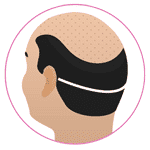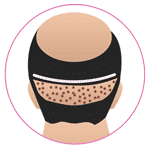Hair loss does not discriminate among different ethnicities, gender, race and geographic distribution. It is increasing in prevalence all over the world and affecting the younger generation too. Every hair loss sufferer desires to have a permanent solution for hair loss which looks natural too. Hair transplant is the only solution for hair loss which offers the permanent and natural outcomes with maximum possible coverage of the bald site.Hair transplant can be performed on hair loss sufferers of any caste, ethnicity and color which are absolutely not a contraindication for the procedure. African population is mostly concerned about the feasibility of hair transplant in their hair loss and about the expected outcomes because of their distinct hair characteristics. But the great news for them is that they can undergo hair transplant surgeries and can achieve excellent outcomes with natural looking results.
The hair community has embraced the following Hair Type guidelines and defined them into 4 types explained as follows:
Hair loss in African American men: Hair loss in African – American men is quite common and is increasing in prevalence year by year. Almost all of the men at certain age possess receding hairline termed mature hairline. It has been found that approximately 65 % of the men suffer from hair loss facing harsh consequences but majority of them are at their late 30s.
Hair loss in African American women: Hair loss in African American women is incredibly common. Approximately 47.6% of the women are reported to have hair loss on the crown or top of the scalp.
African American women have genetic predisposition to hair loss, but styling aids makes it even more worse. African women usually prefer tight braiding hair styles and also use chemical relaxers for straightening their hairs frequently. These chemical straighteners are effective in straightening the hairs but negatively influence the strength of hairs leading to more hair loss. These negative effects are intensified by hot tools used regularly to style your hairs.
There are many causes for which hair loss occurs in general but African American population have certain factors which are more commonly involved due to their hair characteristics and styling methods.
Androgenic alopecia: Genetic hair loss stays the most common cause for hair loss worldwide. Pattern baldness or androgenic alopecia occurs due to genetic dysfunction which leads to oversensitive hair follicles. The DHT sensitive areas where the hair follicles are influenced by androgenic hormones are and undergo thinning or miniaturization leading to hair loss.
Ageing: Hair loss impacts almost everyone as age passes. Receding hairline usually occurs with everyone which could be normal termed “mature hairline” or could lead to hair loss.
Traction alopecia: African – American females usually follows a tight braiding and ponytail hairstyle which causes inflammation of the hair follicles. This type of hair loss is self inflicted as due to tight braiding the hairs are pulled and are damaged. It could be treated if stopped at an early stage but repeated tension could lead to permanent hair loss. Traction alopecia usually follows the receding hairline pattern which continues to extend the baldness and involves a broader area.
Traumatic alopecia: Due to styling practices and use of chemicals and hot tools the hairs could become damaged and lead to breakage. African textured hairs are fragile when compared to other hair types which make them more susceptible to hair loss.
Folliculitis induced alopecia: Folliculitis induced alopecia occurs due to inflammation of hair follicles occurring due to bacterial growth in the scalp. Folliculitis occurs due to weaving or braiding the hairs for longer duration leading to scalp pain, little bumps and hair loss.
Hair transplant is an outpatient procedure which is performed under local anesthesia and involves harvesting of hair follicles from the donor area and transplanting them to the recipient bald area. Hair transplant in Africans is highly successful procedure and is a treatment of choice of hair loss. The success rate of the African hair transplant is more than 95 % irrespective of gender.
African hair transplant is usually misjudged as less successful procedure because of the specific hair characteristic of the population. But ideally hair transplant is possible in every hair type in fact curly and thick hairs have an added advantage.
The course of hairs in the African population is wavy or curly with thick texture which gives the illusion of fuller look thus would surely present high density even by transplanting lesser number of hair grafts. Thus, it is possible with these types of hairs to achieve maximum hair density even by harvesting fewer follicular grafts.
The basic hair transplant procedure involves following steps:
The hair transplant procedure takes up to 5 – 8 hours based on the technique opted and on the number of grafts harvested to cover the bald site. After few weeks of hair transplant the newly planted hair follicles undergo shedding which is absolutely normal and part of transplanted hair growth.
You can see the tiny hair shafts emerging from the bald site after 3 months of the hair transplant. After 6 months of the hair transplant procedure the appreciable hair growth can be observed. Complete hair growth can be observed in 9 – 12 months.
African hair transplant in India has become common nowadays as many Africans prefer India as their hair transplant destination. India is well known for their medical fraternity and especially cosmetic surgeries. There are few hair transplant surgeon is India like Dr Suneet Soni who are well known for their surgical and artistic skills and are enlisted among the top ten hair transplant surgeons of the world. Hair transplant surgeons in India are preferred because of their high experience as African hair transplant surgeons have lack of them. African hair transplant surgeons despite being highly qualified usually lack in experience because of the less patient footfall.
African hair transplant cost is quite high as per the standards maintained by the clinics there. Thus, Africans prefer visiting India for their hair transplant as the cost of hair transplant in India is very affordable and few clinics maintain high international standards.
Medispa hair transplant clinic has become the prime destination for African hair transplant as we are one of the most leading hair transplant clinics in India. We have the India’s biggest team of hair transplant who have experience of more than 14 years. Dr Suneet Soni is pioneer in performing hair transplant by delivering world class natural results.
Hair transplant procedures are performed using 2 techniques which are differentiated based on the graft harvesting procedures. The techniques are explained as follows:
The hair characteristic of African population mainly comprise of curly hairs based on which FUT hair transplant is preferred for the hair transplant.
Why FUT technique is preferred for curly hairs?
Curly hairs possess the oblique course initiating from the hair root which lies under the scalp tissues. Thus, it becomes difficult to identify the course of the hair when FUE technique is performed. FUE technique is performed based on assumptions of the location of the hair root and is somewhat a blind procedure. With FUE technique there are high chances of damage to the hair roots which could hamper the coverage of the bald area.
Therefore, FUT technique is preferred as the separation of the hair grafts is performed under high magnification and video assisted microscopes which makes it an inevitable option.
Medispa hair transplant clinics in Jaipur and Delhi are well equipped with high quality armamentarium of latest technology at an affordable cost. We are well known for our huge infrastructure and excellent surgical protocols which is unparalleled and is highly efficient in performing hair transplant with either technique FUT or FUE. Dr Suneet Soni is specialized in performing hair transplant with extremely natural looking hairline design. He has performed N number of cases with curly hair type with successful desirable outcome. Thus, if you are looking for afro hair transplant then visit Medispa clinics for assured successful results.
If you are in doubt whether you can undergo hair transplant or not, then don’t worry any kind of hair type is not a contraindication for going under the knife. In fact with curly hairs there are advantages of achieving high hair volume with fewer hair follicular grafts.
But along with the advantage, you need to be aware that hair transplant in Africans with curly hairs is difficult and precision based which needs to be performed by extremely skilled hands to achieve the desirable outcomes. So let’s look for the challenges for performing hair transplant in African – Americans:
Therefore, the solution to overcome these challenges is to find a competent surgeon for African hair transplant in India. Dr Suneet Soni is one such hair transplant surgeon who is highly skilled and believes in keen observation of every minute details which has made him successful in achieving the best possible hair transplant with least damage rate of <1%. He is appreciated and recognized worldwide for his artistic vision to design extremely natural hairline.
Q1: Can I choose the shape of hairline prior to surgery?
Ans: Yes, you can choose the hairline design prior to the hair transplant surgery. Your hair transplant surgeon will surely advise you the hairline design based on your sex, age and facial profile but if you want any change in detailing you can surely get that done before the surgery.
Q2: Will I need fewer grafts than a Caucasian patient?
Ans: Yes, if you have curly hairs or wavy hair type then you are fortunate to get higher hair volume and coverage with fewer hair grafts comparing to the one with straight hair type. But you need to be aware that the damage rate of hair grafts in curly or wavy hair type is more so you need to find the best hair transplant surgeon to perform the procedure.
Q3: Are there any specific risks to African patients?
Ans: There are challenges while performing hair transplant in African – American patients as the damage rate could be high in curly hair type and hairline designing is bit difficult in them. But to minimize the challenges the best solution is to find a competent hair transplant surgeon.
Q4: Is Growth factors a good option for African patients?
Ans: Yes, growth factors or PRP therapy could be a good option to achieve the better hair growth and better healing post hair transplant as these growth factors provides a better environment for transplant hairs to grow.
So if you are looking for the best African hair transplant surgeon in India and have any queries regarding hair transplant for Africans patient, feel free to visit Medispa hair transplant clinics in Jaipur and Delhi (India) for the best experience of hair transplant.

The FUE hair transplant is widely applicable in the case of body hair transplant (BHT), eyebrow transplant, moustache transplant or if there is a very small Norwood grade of baldness. Dr Suneet Soni recommends it in a very special purpose if there is need to cover the higher grade of baldness for that expert Surgeon applies the combination method of the hair transplant, i.e., FUT+FUE hair transplant also knows Mega/Giga session

Dr Suneet Soni, founder of the Medispa Hair Transplant Centre, Jaipur, New Delhi (India) says that FUT is a Gold standard technique of hair transplant and if performed well by the skilled hands, supported by trained technicians and aided with the innovative and advanced equipment works, can cover a higher bald area in a single sitting without damaging any graft numbers.

Dr Suneet Soni has expertise in performing hair transplant with any technique FUT, FUE or BHT with best results. He is well known to perform hair transplant with least damage rate of <1%. His judicious and holistic approach makes him take sound decision of choice of technique in the best interest of patients. .